| Reviews & Columns |
|
Reviews DVD TV on DVD Blu-ray 4K UHD International DVDs In Theaters Reviews by Studio Video Games Features Collector Series DVDs Easter Egg Database Interviews DVD Talk Radio Feature Articles Columns Anime Talk DVD Savant Horror DVDs The M.O.D. Squad Art House HD Talk Silent DVD
|
DVD Talk Forum |
|
|
| Resources |
|
DVD Price Search Customer Service #'s RCE Info Links |
|
Columns
|
|
|
Carlos Saura's Flamenco Trilogy - Eclipse Series 6
THE MOVIES:
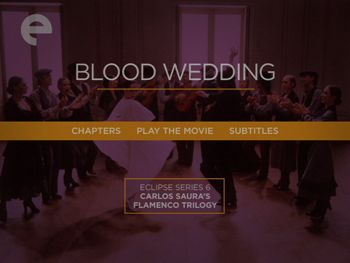
Over the past couple of months, Criterion has been doing their level best to elevate how traditional, performance-based dance is represented in the DVD field. First with their release of Martha Graham: Dance on Film, and now their bundling of Carlos Saura's Flamenco Trilogy as the sixth entry in their Eclipse Series, the studio is giving home viewers the chance to see that there is more to cutting a rug than can be seen on "Dancing with the Stars."
Made between 1981 and 1983, the three films here are invaluable and supremely entertaining chronicles of a dancing style that is integral to Spain's artistic identity. Carlos Saura was an early pioneer of the Spanish Neorealist movement in the 1960s, and his illustrious career continues to this day. The Flamenco Trilogy is probably his best known work.
The first in the series is Blood Wedding (1981; 71 minutes), and it establishes the technique and tone of this set of films. Shot in a style that blurs the lines between documentary and performance, Saura chronicles the day of one dance company, from arrival through the preparation of stage make-up, the warm-up routine, and then a full rehearsal of the flamenco ballet Blood Wedding. The performance is a traditional operatic tale. On the wedding day of one couple, it is discovered that the bride has been having an affair with a married man. Uncovered by the cheater's spurned wife, the lovers flee, pursued by the woman's jilted fiancée. A knife fight leads to one inevitable outcome. The dance troupe performs the play for Saura's camera, captured from multiple angles, and though Saura jumps between them, most of the shots are long and focused, maintaining the feel of a seamless, uninterrupted performance. The dancers are accompanied by a live band and singers, all of whom move in and out of the action, serving as members of the wedding party.
By filming in the rehearsal studio rather than on a stage, Saura maintains an intimacy that isn't possible when shooting over an audience's heads in a theatre. He also pulls the viewer into the dance experience via the everyday details he captures backstage. More importantly, he makes the troupe's leader, Antonio Gades, who also choreographed the flamenco and adapted it from a story by Federico Garcia Lorca, our main character. While Gades silently applies make-up, Saura overlays a recording of him explaining his life and how he ended up becoming a dancer. This gives us a personal connection to Gades, even when he plays Leonardo, the dastardly adulterer in Blood Wedding.
Like all dancers, the flamenco performers have tremendous control over their bodies. Though some of the movements seem familiar to anyone who has seen straight-up ballet, in this context, they seem more forceful and violent to me. Confident kicks punctuate many moves, the hard-soled shoes of the dancers resounding loudly on the wooden floor. They mime holding babies and riding horses, but the scene that really got me was the duel between Leonardo and the cuckold Groom (Juan Antonio Jimenez). Using prop knives, they dance the back-and-forth hack-and-slash in slow motion, turning their muscles to molasses, bringing out the bloodlust with an intense vigor that would not be visible at normal speed. In a weird way, the more in control the dancers are, the more able they are to show how out of control the fighters are. It has a tremendous impact.
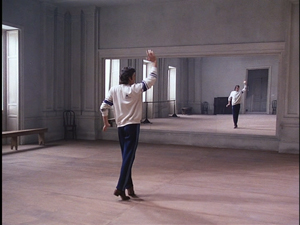
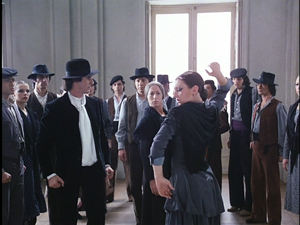
Rather than just repeat the same approach when Saura and Gades teamed up again in 1983, Carmen (101 minutes) shifts from the documentary approach to something more resembling a traditional melodrama. In a way, it's almost like we are seeing the fictionalized version of the first movie. We still have Gades and his troupe, and the movie opens with a rehearsal for his new ballet. Gades is trying to create a new Carmen dance piece using the famous Georges Bizet opera while also going back to the original Prosper Merimee novel. We see him trying out steps, hashing over the music, and most important, worrying over who his lead will be. He decides to cast a wide net and visit regional dance schools to find a new Carmen.
And this he does, meeting a dancer whose real name is Carmen. Played by Laura del Sol, Carmen is sensual, voluptuous, headstrong, and a little bit of a mess. Antonio rejects her at first, but he can't get her out of his head. Once she's on board, the production begins to take shape. Full dance rehearsals are interspersed with the backstage drama that erupts when Antonio becomes obsessed with his new dancer. His life is starting to resemble the ballet he is trying to perform.
In Blood Wedding, we see the real life aspect of performance, and we also get the feeling that for the participants, dancing is their life. Carmen pushes the same concept to its next logical step, ironically using fiction to show us that dancers are their dance. Unfortunately, Carmen is a tad less effective than the preceding film, largely because the melodrama is undercooked. The dance numbers are still incredible, especially a wonderful face-off between Carmen and the older dancer she replaced (Cristina Hoyos), and the cliché story elements they relate are forgivable because the canvas is meant to be larger. The scenes of Antonio struggling with his muse are no different than anything we've seen before and at their best are merely functionary stopgaps between the bigger music. It doesn't stop Carmen from being a good movie (and Saura was certainly more successful than Robert Altman would be years later, applying the same technique for his ballet film The Company), but in comparison to its siblings, it's the runt of the litter for me.
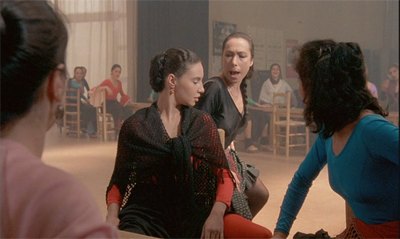
The third collaboration of Saura and Gades came three years after Carmen. El amor brujo (Love, the Magician) (1986; 103 minutes) continues to advance the melding of movie and performance, this time dropping the pretense of a staged production almost completely. The opening crane shots lead us into a soundstage, showing us the cracks between warehouse and movie set, but once the camera settles into the gypsy village where Manuel de Falla's drama will play out, the reality of the dance will be the only reality.
Not that it's a realistic presentation, mind you. Saura isn't returning to his Neorealist roots; rather, he's indulging in the illusion of movies, creating the façade for Gades and company to perform in front of. Though the village itself is built to look real, Saura's backgrounds are the wide walls of the soundstage, and he uses his sky as an expressionistic canvas, changing the colors to fit the mood of the scene, from white to blue to a lusty pink.
El amor brujo is the story of a love triangle in a gypsy village. As children, Carmelo was in love with Candela, but the day she became betrothed to Jose, his heart broke. As an older man, Carmelo (Gades) can only watch as his beloved (Hoyos) marries the carousing cad (Jimenez) her father picked out for her. Even after the deal is sealed, Jose keeps stepping out with Lucia (del Sol), whose wanton ways lead him into a knife fight to defend her honor. In the rumble, Jose is killed and Carmelo is sent to jail. He returns to his village four years later to find Candela haunted by her husband's ghost, and Carmelo has to figure out how to break this bond so he can finally realize his own passions for her.
El amor brujo is the perfect stylistic conclusion to this trilogy, an expert coupling of flamenco and cinema. Both mediums are suited to grand gestures, both are confined to the limits of their stage, be it the physical boards of a traditional dance theatre or the borders of a movie screen. Over the course of the Flamenco Trilogy, Carlos Saura maneuvers around the various layers of performance, looking at the real mechanics and the driving force of artistic expression before finally settling into the full, illusory reality of the performance itself.
And yet, even with all of these other things going on, the dancing remains the most important. This is why any complaints about the melodramatic backstage elements in Carmen are ultimately moot. It's the flamenco we're really watching these films for, the fiery and passionate dancing. As collaborators, Carlos Saura and Antonio Gades, the film director and the choreographer, play to each other's strengths, preserving the integrity of the flamenco while applying cinematic technique. It's never as simple as setting up a camera and shooting the ballet straight on, but something more, putting the spectator into the action and letting us feel the reverberations.
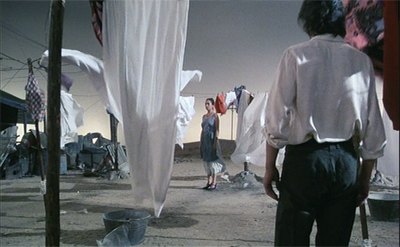
THE DVD
Video/Sound:
Of the three discs in Carlos Saura's Flamenco Trilogy - Eclipse Series 6, only Blood Wedding is shown in a full frame aspect ratio (1.33:1). It also is the transfer that is the worst for wear. There are spots and scratches on the print throughout. They aren't persistent or constant, but no scene is perfect. The colors, on the other hand, are nice and the resolution solid.
The other two movies, Carmen and El amor brujo are widescreen, 1.66:1 aspect ratio. Carmen looks excellent, with very little by way of bruising or damage, leaving El amor brujo to land somewhere in the middle. From time to time, some surface wear appears on the frame, but it doesn't stick around for long.
All three movies maintain the original Spanish soundtracks. Blood Wedding and Carmen are mono mixes, and El amor brujo is stereo. You can definitely tell the difference in the case of the latter, the mix does have more power, but the sound quality of the other two films is just fine. All three have removable English subtitles.
Extras:
The Eclipse Series' mission statement is that they present "a selection of lost, forgotten, or overshadowed classics in simple, affordable editions." What this means is no extras, no bells and whistles, not even the massive restoration job Criterion gives to its regular editions (hence, a less than perfect transfer on Blood Wedding). So, the only bonus we get with Carlos Saura's Flamenco Trilogy - Eclipse Series 6 is the liner notes that are printed on the inside of each DVD case. The movies are each held in their own slimline plastic case, which are then wrapped in a cardboard slipcase.
FINAL THOUGHTS:
Carlos Saura's Flamenco Trilogy - Eclipse Series 6 is an intriguing set, showcasing Spain's traditional dancing style while also deconstructing the nature of performance on stage and screen in order to eventually bring everything back around to find a new way for the two mediums to work together. The set is easily Recommended, particularly for dance enthusiasts. The three movies here--Blood Wedding, Carmen, and El amor brujo--keep the performances of Antonio Gades' dance troupe front and center, giving us the high swathes of emotion inherent in these bawdy stories of lust and heartbreak. Even when the narrative is weak, the movement and physical control exhibited by the dancers is breathtaking. More than musicals, more than concert recordings, Carlos Saura's Flamenco Trilogy - Eclipse Series 6 busts genres and digs through the layers to bring up all the passion flamenco has to offer.
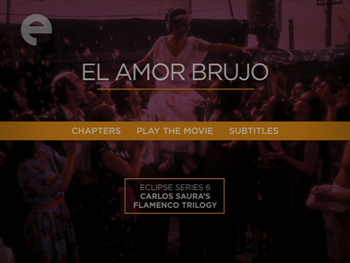
Jamie S. Rich is a novelist and comic book writer. He is best known for his collaborations with Joelle Jones, including the hardboiled crime comic book You Have Killed Me, the challenging romance 12 Reasons Why I Love Her, and the 2007 prose novel Have You Seen the Horizon Lately?, for which Jones did the cover. All three were published by Oni Press. His most recent projects include the futuristic romance A Boy and a Girl with Natalie Nourigat; Archer Coe and the Thousand Natural Shocks, a loopy crime tale drawn by Dan Christensen; and the horror miniseries Madame Frankenstein, a collaboration with Megan Levens. Follow Rich's blog at Confessions123.com.
|
| Popular Reviews |
| Sponsored Links |
|
|
| Sponsored Links |
|
|
| Release List | Reviews | Shop | Newsletter | Forum | DVD Giveaways | Blu-Ray | Advertise |
|
Copyright 2024 DVDTalk.com All Rights Reserved. Legal Info, Privacy Policy, Terms of Use,
Manage Preferences,
Your Privacy Choices | |||||||














